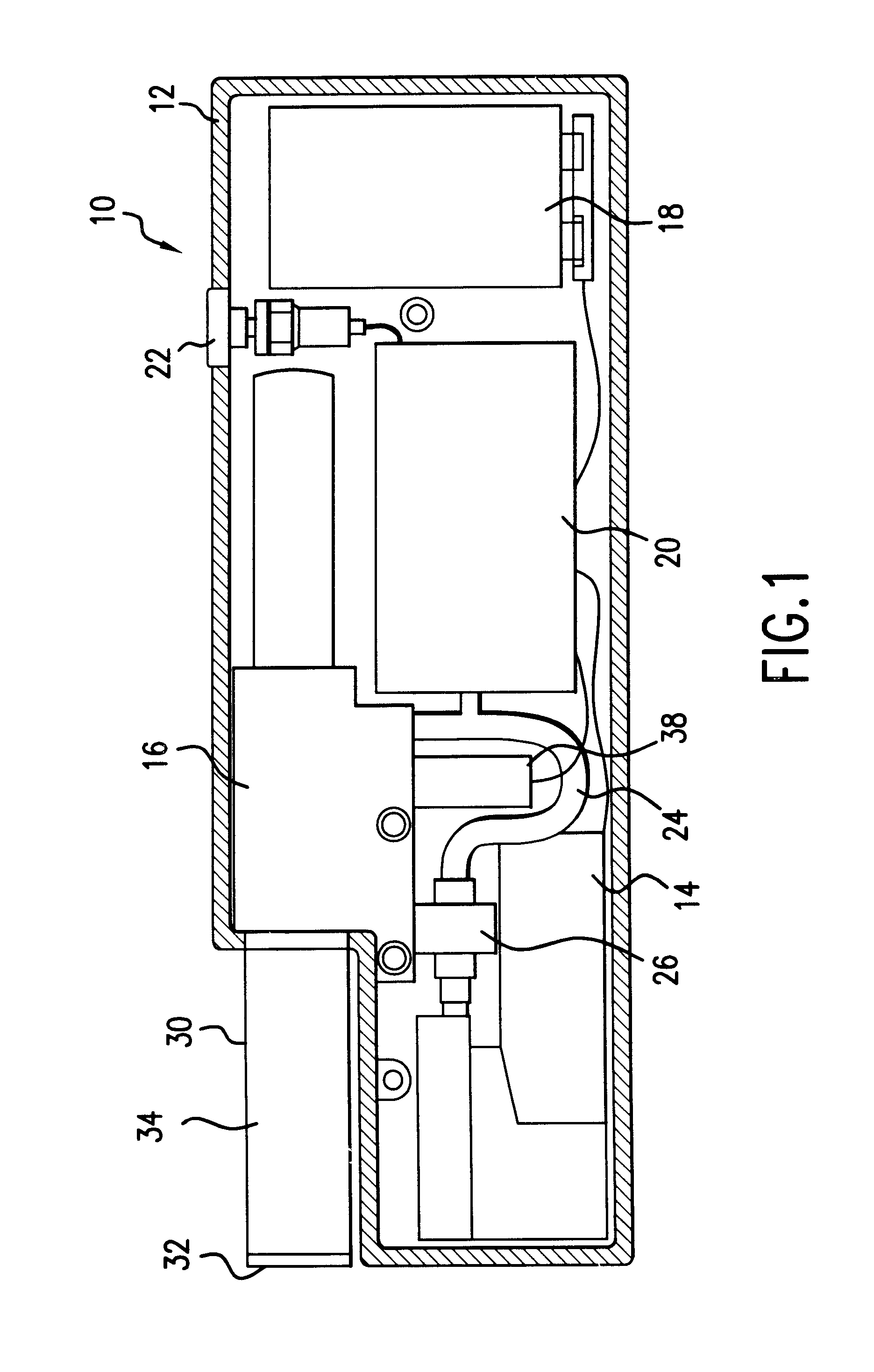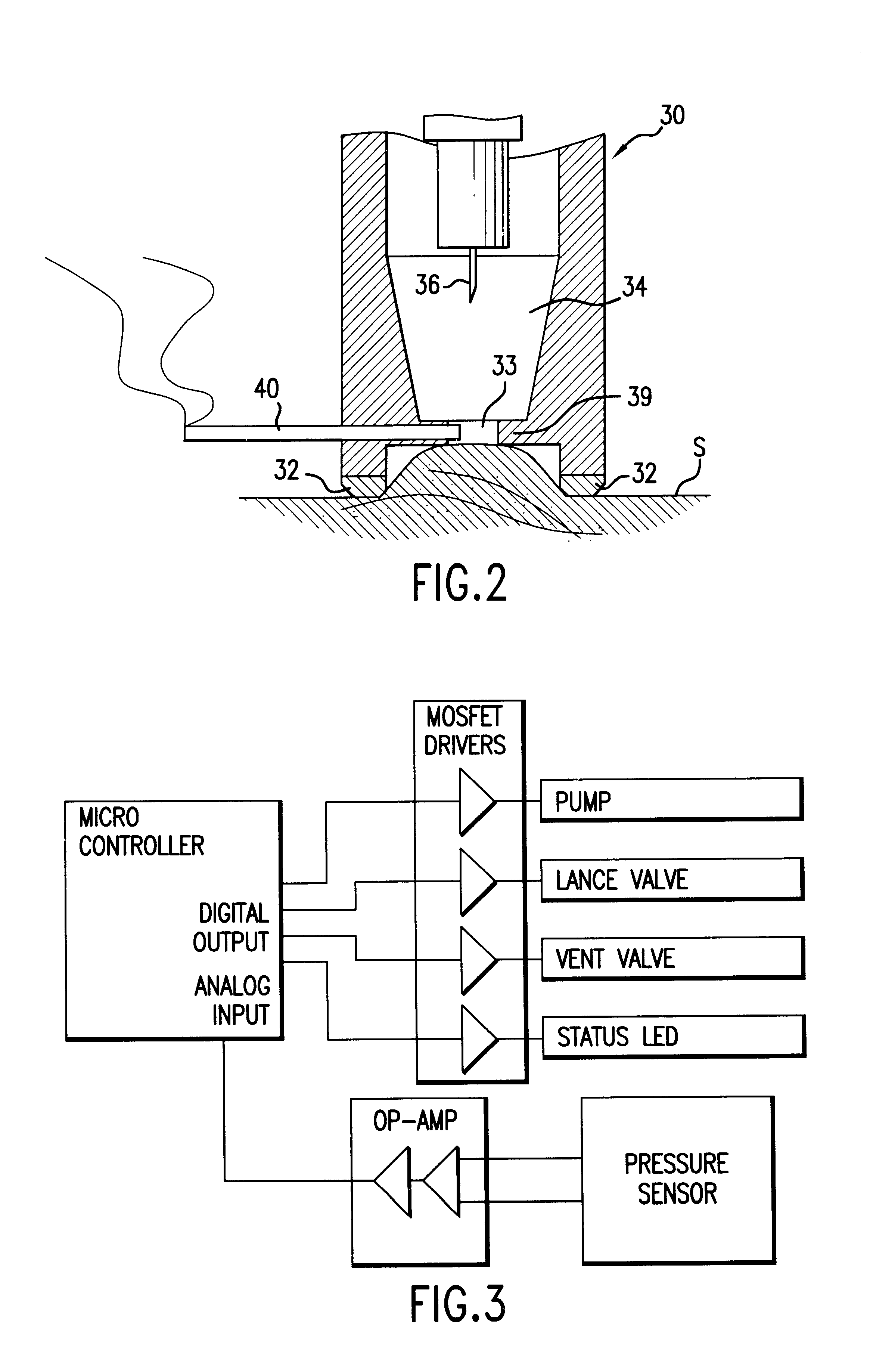Method and apparatus for obtaining blood for diagnostic tests
a technology for blood and diagnostic tests, applied in the field of methods and apparatus for obtaining blood for diagnostic tests, can solve the problems of blood sampling of the arm, finger lancet leads to even more pain, finger lancet presents another problem, etc., and achieves the effect of reducing the time required for extracting the sample, avoiding finger lancet use, and increasing the availability of blood
- Summary
- Abstract
- Description
- Claims
- Application Information
AI Technical Summary
Benefits of technology
Problems solved by technology
Method used
Image
Examples
example 1
This example illustrates that greater volumes of blood can be extracted and collected by applying a vacuum, pulsed or continuous, after piercing than can be extracted and collected when no vacuum is applied. No vacuum was applied prior to piercing.
Each of four people had his forearm (dorsal forearm) punctured four times (at four different positions on the forearm) with a “BD ULTRA-FINE” lancet in a “MEDISENSE” lancet assembly (Model no. 97101) at two different levels of vacuum (−2.5 psig and −5.0 psig) and for each different vacuum pulsing frequencies (0, 0.2, 0.8, 3.2, 12.8, 25, 100 hertz). The vacuum was applied with a pipette tip having a diameter of 8 mm (“RAININ RT-200”). Four control runs without a vacuum were also carried out (one puncture per person). A total of 60 punctures per person were carried out. Accordingly, it can be seen that a total of 240 runs were carried out.
The vacuum was applied for a duration of 30 seconds after puncturing. Blood was collected into capillary...
example 2
This example illustrates that application of vacuum prior to piercing as well as after piercing results in a greater volume of blood extracted than does the application of vacuum only after piercing.
Each of four people had his forearm (dorsal forearm, middle of forearm) punctured sixteen times (at sixteen different positions on the forearm) with a “BD ULTRA-FINE” lancet in a modified “MEDISENSE” lancet assembly at four different levels of vacuum. The four levels of vacuum used were −2.5, −5.0, −7.5, and −10.0 psig. The “MEDISENSE” lancet device was modified to allow vacuum to be pulled through the lancet assembly. Four punctures per person were carried out at each of the four levels of continuous vacuum. Accordingly, it can be seen that a total of 64 runs were carried out.
Prior to puncturing, the vacuum was applied for a period of 30 seconds; subsequent to puncturing, the vacuum was applied for a period of 30 seconds. The skin was under vacuum at the time the lancet was triggered. A...
example 3
This example illustrates that localized heating of the area to be pierced followed by vacuum after piercing results in a greater volume of blood being extracted than does extraction with only vacuum after piercing.
Each of four people had his forearm (dorsal forearm, middle of forearm) punctured eight times (at eight different positions on the forearm) with a “BD ULTRA-FINE” lancet in a “MEDISENSE” lancet assembly with heat applied (45° C.) prior to piercing for two different time periods, 15 seconds and 60 seconds A total of 32 runs were carried out, 16 runs where the pre-heating duration was 15 seconds and 16 runs where the pre-heating duration was 60 seconds.
Heat was applied with a heating block, which was an aluminum block having a square face covered with a “KAPTON” film heater element controlled by an “OMEGA” DP41 temperature controller using a T-type thermocouple. Vacuum was applied after each puncturing for 30 seconds at −5.0 psig. Blood was collected into capillary tubes. Th...
PUM
| Property | Measurement | Unit |
|---|---|---|
| volumes | aaaaa | aaaaa |
| volumes | aaaaa | aaaaa |
| volume | aaaaa | aaaaa |
Abstract
Description
Claims
Application Information
 Login to View More
Login to View More - R&D
- Intellectual Property
- Life Sciences
- Materials
- Tech Scout
- Unparalleled Data Quality
- Higher Quality Content
- 60% Fewer Hallucinations
Browse by: Latest US Patents, China's latest patents, Technical Efficacy Thesaurus, Application Domain, Technology Topic, Popular Technical Reports.
© 2025 PatSnap. All rights reserved.Legal|Privacy policy|Modern Slavery Act Transparency Statement|Sitemap|About US| Contact US: help@patsnap.com



